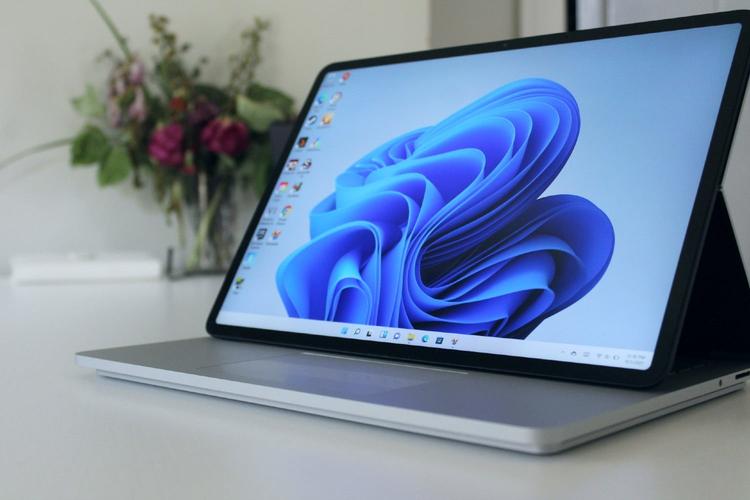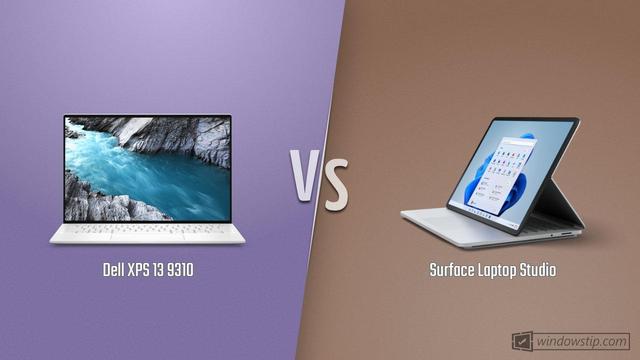
Surface Laptop Studio vs. XPS 13: Laptops face off
The Dell XPS 13 has been at the top of our best laptops list for a few years now, thanks to its combination of build quality, good looks, excellent performance, and optimal size for a 13-inch machine. Microsoft’s Surface Studio Laptop is a newer device that takes a spot at the top of the Surface performance heap. Soon enough, it’s likely to make our list of best 2-in-1s, too.
ContentsThese laptops couldn’t be more different in their designs, but they still go after many of the same users. Read on to discover which is the better machine for you.
Specs
| Microsoft Surface Laptop Studio | Dell XPS 13 | |
| Dimensions | 12.72 inches by 8.98 inches by 0.746 inches | 11.64 inches x 7.82 inches x 0.58 inches |
| Weight | 4.0 pounds | 2.8 pounds |
| Processor | Intel Core i5-11300HIntel Core i7-11370H | Intel Core i3-1115G4Intel Core i5-1135G7Intel Core i7-1185G7Intel Core i7-1195G7 |
| Graphics | Intel Iris XeNvidia GeForce RTX 3050 Ti | Intel Iris Xe |
| RAM | 16GB32GB | 8GB LPDDR416GB LPDDR432GB LPDDR4 |
| Display | 14.4-inch 3:2 IPS 2,400 x 1,600 | 13.4-inch 16:10 IPS Full HD+ (1,920 x 1,200)13.4-inch 16:10 IPS Full HD+ touch13.4-inch 16:10 OLED 3.5K (3,456 x 2,160) touch13.4-inch 16:10 IPS UHD+ (3,840 x 2,400) touch |
| Storage | 256GB PCIe SSD512GB PCIe SSD1TB PCIe SSD2TB PCIe SSD | 256GB SSD512GB SSD1TB SSD2TB SSD |
| Touch | Yes | Optional |
| Ports | 2 x USB-C with Thunderbolt 41 x Surface Connect3.5mm audio jack | 2x USB-C with Thunderbolt 43.5mm audio jackMicroSD card reader |
| Wireless | Wi-Fi 6 and Bluetooth 5.1 | Wi-Fi 6 and Bluetooth 5.1 |
| Webcam | 720p | 720p, Windows Hello IR webcam |
| Operating system | Windows 11 | Windows 10 or 11 Home or Pro |
| Battery | 58 watt-hour | 52 watt-hours |
| Price | $1,599+ | $950+ |
| Rating | 4.5 out of 5 stars | 5 out of 5 stars |
Design
The XPS 13 is a traditional clamshell laptop, with tiny bezels that help a 13.3-inch display fit into a diminutive chassis. Even so, it’s incredibly well-built, with a mix of CNC-machined aluminum and either glass (white) or carbon fiber (black) depending on the color of the keyboard deck. It’s the perfect size for anyone who wants a smaller laptop to meet their performance and efficiency needs.
The Surface Laptop Studio is a convertible 2-in-1 with a 14.4-inch display, with the usual pull-forward design that allows the display to tilt forward into media mode or all the way to tablet mode. When used as a clamshell, it strikes a familiar pose but pull the display forward, and it takes on a very different look. Constructed of CNC-machined aluminum, the Surface Laptop Studio is also a very sturdy machine.
Aesthetically, the XPS 13 and Surface Laptop Studio both enjoy conservative good looks. The XPS 13 benefits from its dual-tone color scheme, either silver and black or silver and white, and it has just the right angles to keep it sleek, modern, and simplistic in terms of looks. The Surface Laptop Studio stands out as a 2-in-1, with a single silver color and little to no bling to detract from its minimalist appeal. Its one standout feature is a row of vents along the bottom of the chassis that lend a bit of modernity to the design. If an attractive laptop is one of your purchase criteria, you can’t go wrong with either laptop.
In terms of size, the Surface Studio Laptop is an inch wider and deeper, thanks to its larger display. It’s thicker at 0.75 inches, versus 0.58 inches for the XPS, and heavier at 4.0 pounds, versus 2.8 pounds for the XPS. Both laptops are comfortable in their display sizes and overall designs, but there’s no doubt that the XPS 13 is the smaller machine by a wide margin.

The XPS 13 has one of the best keyboards you’ll find on a Windows machine, with sufficient travel, large keycaps, and a precise and snappy mechanism. The Surface Laptop Studio also enjoys an excellent keyboard, with deep travel and a comfortable bottoming action that’s just as precise as the XPS 13’s. The keycaps could be a bit larger, but Microsoft’s machine enjoys a superior keyboard overall.
The touchpad is a different matter. While the XPS 13 has a smaller physical touchpad that’s comfortable and precise thanks to Microsoft Precision touchpad drivers, it can’t hold a candle to the Surface Laptop Studio’s haptic touchpad. Our reviewer found it exceeded even Apple’s version, providing a button press simulation that feels like the real thing. And you get all the advantages of haptic touchpads, like the ability to click anywhere and get a consistent response. Both laptops offer touch displays, but the Surface Laptop Studio goes one further and supports the Surface Slim 2 pen — which also provides haptic feedback for a more realistic pencil-on-paper feel.
Finally, connectivity is almost equal. The XPS 13 offers two USB-C with Thunderbolt 4 ports, a 3.5mm audio jack, and a microSD card reader. The Surface Laptop Studio also has two USB-C with Thunderbolt 4 ports and a 3.5mm jack, to go with the usual Surface Connect port, but there’s no SD card reader. Both laptops support Wi-Fi 6 and Bluetooth 5.1. Note that the Surface Laptop Studio’s webcam is a 1080p version, an step up from the XPS 13’s 720p webcam.
Performance
The Surface Laptop Studio features a 35-watt quad-core H-series Intel 11th-gen CPU that gives it a boost in performance over the 28-watt quad-core U-series Intel 11th-gen CPUs in the XPS 13. The difference isn’t tremendous, but it’s enough to make Microsoft’s machine a better candidate for creative work. That’s particularly true if you opt for the Nvidia GeForce RTX 3050 Ti discrete GPU in the Surface Laptop Studio, as the XPS 13 is limited to Intel’s Iris Xe integrated graphics.
In all our benchmarks, Microsoft’s 2-in-1 is the faster machine. In our Handbrake test that encodes a 420MB video as H.265, the Surface Laptop Studio completed the run in 179 seconds compared to the XPS 13 at 201 seconds. In Cinebench R23, the XPS 13 scored 1,399 in the single-core mode and 4,585 in the multi-core mode, compared to the Surface Laptop Studio at 1,304 and 5,450. Again, the difference isn’t profound, but it’s enough to give the Surface Laptop Studio the edge.
And in applications like Adobe’s Creative Suite that can utilize the discrete GPU, Microsoft’s 2-in-1 takes an even more significant lead. That’s not to mention gaming, where the Surface Laptop Studio can handle modern titles at 1080p and reasonable graphics settings.
Display
Dell offers several 16:10 13.3-inch displays for the XPS 13, including a Full HD (1,920 x 1,080) touch IPS display, a 4K (3,840 x 2,160) IPS touch panel, and a 3.5K (3,456 x 2,160) touch OLED screen. The latter is particularly excellent, offering extremely wide and accurate colors, inky blacks, and tons of brightness. The Surface Laptop Studio offers just one 3:2 14.4-inch display at 2,400 x 1,600. It offers better-than-average color width and accuracy and deep contrast for an IPS display, but it can’t compete with the XPS 13’s OLED panel.
Microsoft’s display is superior in its 120Hz refresh rate, which makes Windows 11 so much more enjoyable. Moving windows and scrolling through webpages is as smooth as silk. High refresh rates are making their way to non-gaming laptops, and the Surface Laptop Studio is at the vanguard. The XPS 13’s 60Hz displays can’t keep up in this regard.
Portability
As mentioned, the XPS 13 is by far the smaller and more portable laptop. The Surface Laptop Studio isn’t huge by any means, but you’ll slip the XPS 13 more easily into your backpack and forget about it.
Battery life is a different story. The XPS 13 has 52 watt-hours of battery compared to the Surface Laptop Studio’s 58 watt-hours, which isn’t a significant advantage in the latter’s favor. Nevertheless, Microsoft managed to squeeze a lot more battery life out of its 2-in-1. For example, in our web-browsing test, the XPS 13 with a 4K display lasted for about 6.5 hours compared to the Surface Laptop Studio at over 10 hours. And in our video-looping test, the Surface Laptop Studio managed 14 hours compared to the XPS 13’s 10.5 hours.
Sure, you could opt for a Full HD display in the XPS 13 and get better battery life, probably approaching the Surface Laptop Studio’s, but Microsoft’s machine manages to give you both high resolution and longevity.
The Dell XPS 13 is a more refined laptop, but it’s close
The XPS 13 starts at $980 for a Core i5-1135G7, 8GB of RAM, a 256GB solid-state drive (SSD), and a Full HD touch display. It maxes out at $2,078 for a Core i7-1195G7, 32GB of RAM, a 2TB SSD, and either the 4K IPS or the 3.5K OLED display. It starts as a midrange machine and ramps up quickly into premium territory.
The Surface Laptop Studio is a more expensive machine, starting at $1,600 for a Core i5-11300H, 16GB of RAM, a 256GB SSD, and Intel Iris Xe graphics. At the high end, it’s $3,100 for a Core i7-11370H, 32GB of RAM, a 2TB SSD, and the RTX 3050 Ti. It’s a phenomenally expensive laptop.
The Microsoft Surface Laptop Studio is a fascinating laptop with serious flexibility and some power for creative applications, but it’s more of a niche laptop and it’s high price tag is off-putting. The Dell XPS 13 is still the most refined and accessible laptop on the market today, offering more machine for more people, and for less money.
}})